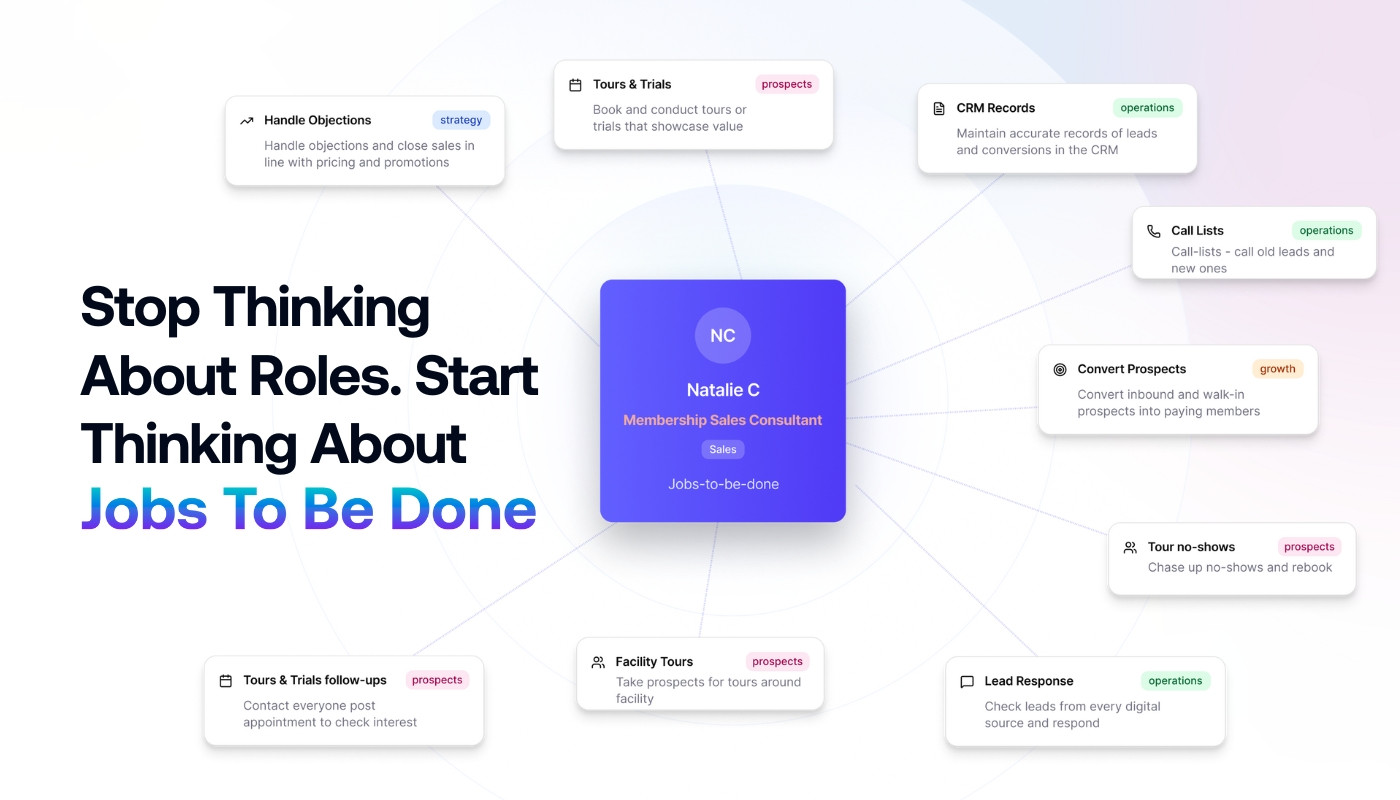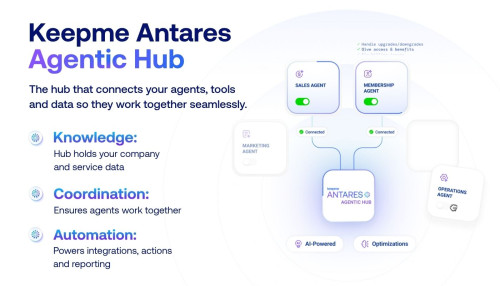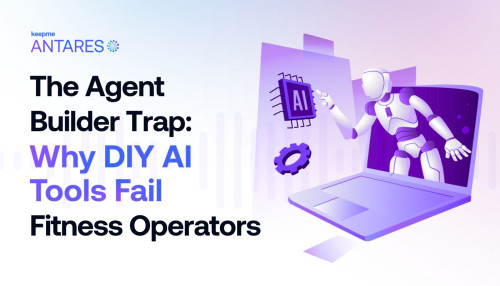Stop Thinking About Roles. Start Thinking About Jobs to Be Done


If you're exploring AI for your fitness operation, you've likely hit the same mental roadblock everyone does: "Which roles will AI replace?"
It's the wrong question.
There's a business framework called Jobs to Be Done, popularised by Harvard's Clayton Christensen, that's incredibly useful here. Originally developed to understand what customers actually "hire" products to do, it shifts focus from demographics and features to the fundamental job someone needs accomplished.
Applied to AI implementation, it means this: instead of looking at entire positions (your membership consultant, your front desk manager, your operations executive), look at the individual jobs that need doing within your business.
AI agents don't need to replicate a full human role to be valuable. They can take on a single job within that role. Or three jobs across multiple roles. Or yes, occasionally, an entire role if that makes sense.
Let me give you a concrete example. At Keepme, our Antares agent handles the complete lead-to-door journey for fitness operators. It converses with prospects across all channels (website forms, social messages, SMS) and guides them from first contact through to their first visit. That's an entire job to be done, one that previously sat with salespeople, front desk staff, or membership teams depending on the operator.
But not every AI implementation needs to be that comprehensive.
Think about end-of-month performance reporting. That's a job to be done. Currently, it probably lives with your general manager or operations lead. It takes hours, it's tedious, and it happens when they're already stretched thin closing out the month. An AI agent could own that job completely (pulling data, identifying trends, generating reports) while your GM focuses on what to do with those insights.
Or front-of-house staff scheduling. Another job to be done. It requires juggling availability, peak times, skill sets, and labour costs. It's time-consuming, it's detailed, and one mistake cascades into coverage issues. This is exactly the kind of job AI handles well.
Or retention management. Identifying members showing signs of disengagement and initiating contact before they ghost. High volume, needs consistency, requires speed. Perfect for an agent.
The pattern you'll notice: these jobs share characteristics that make them ideal for AI. They're either high-volume (too many for your team to handle consistently), highly repetitive (nobody particularly enjoys doing them), or demand perfect consistency (where human variability becomes a weakness).
This is the reframe: don't ask "What roles might AI replace?" Ask "What jobs need doing that AI could handle better, faster, or more consistently?"
But Once You've Made That List, Where Do You Start?
This is where most operators get stuck. You map out fifteen potential jobs, and suddenly you're paralysed by choice. Which one first?
Here's a simple prioritisation framework:
Quick Wins (Start Here)
These are high-volume, low-complexity jobs. Inquiry response. Appointment confirmations. Class reminder messages. They're repetitive, they're time-consuming, and they don't require sophisticated judgment calls.
Start here because the ROI is immediate, implementation is straightforward, and success builds confidence (both yours and your team's). You prove the concept before tackling anything complex.
High Impact (Plan for These Next)
These are jobs where inconsistency creates genuine risk or cost. Member retention triggers that catch disengagement early. Billing issue resolution that prevents cancellations. Follow-up sequences after trials that convert at higher rates when done properly.
These deliver bigger value, but they typically need more thoughtful setup. You want your first AI implementation behind you before you tackle these, because you'll have learned what works in your operation.
Strategic (Design Carefully)
These are jobs that unlock other improvements or involve particularly sensitive touch points. Staff scheduling that affects morale and labour costs. Complaint management that can make or break member relationships. Programming adjustments based on attendance patterns.
Higher stakes. More variables. More need for human oversight, at least initially. Don't start here, but don't ignore them either. These belong in your 6-12 month roadmap once you've got confidence in how AI operates within your business.
When you look at your operation through the Jobs to Be Done lens, you'll start seeing opportunities everywhere. Not because you're looking to cut staff, but because you're looking to remove bottlenecks, reduce tedious work, and free your people to do what humans do best: build relationships, solve complex problems, and create the culture that makes your facility special.
The fitness industry runs on human connection. AI isn't here to replace that. It's here to handle the jobs that get in the way of it.
So grab a coffee, pull up your org chart, and start listing: What are all the jobs that need doing? Which ones create bottlenecks when volume spikes? Which ones would your team happily hand off tomorrow?
Then prioritise using the framework above.
That's your AI roadmap.
Some AI tools worth checking out.
Aqua Voice - I would guess I use my keyboard for less than 10% of my input these days. The article above being an example of something completely done using just voice. This is more than just dictation it is a game changer when it comes to productivity and a core product within the team at Keepme
Comet browser - Chrome has been my go-to browser since the beginning. Google, my search engine of choice. But over the past two months, I’ve switched to the Comet browser, and I haven’t looked back. This isn’t just a better browser; it’s a glimpse into the future. AI-powered and deeply integrated, Comet is something that’s best experienced rather than explained.
Until recently, you needed a $200-a-month Perplexity subscription to get access to anything close to this. Now it’s available to everyone — and I highly recommend you dive in and try it for yourself.
Further Reading
Real AI Agents and Real Work - AI agents can now complete real, economically valuable tasks, nearing human capability. While not perfect, they’re rapidly improving. The article is advocating thoughtful adoption—using AI as a first draft tool and involving humans for quality and judgment to boost real productivity in high value tasks.
A Leap of Trust: AI Agents Are Winning Hearts and Wallets - AI agents have crossed the chasm. Three in four companies invested in them last year, and more than half plan to scale further. In many cases they’re already live, delivering cost savings, speed, and measurable outcomes. Trust remains the barrier, but it’s falling fast. Dive into the full G2 2025 AI Agents report to see what’s really happening.
---3.png)


